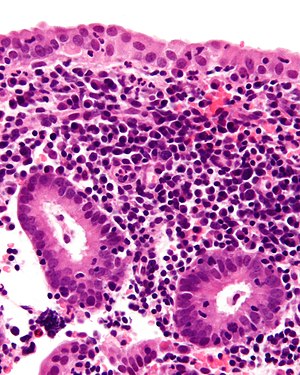Endometritis
Endometritis is inflammation of the endometrium. It usually subdivided into acute and chronic.
| Endometritis | |
|---|---|
| Diagnosis in short | |
 Chronic endometritis. H&E stain. | |
|
| |
| LM | acute: abundant neutrophils; chronic: plasma cells (key feature), often eosinophils, lymphoid aggregates |
| Subtypes | acute, chronic |
| LM DDx | menstrual endometrium |
| Site | endometrium |
|
| |
| Prevalence | uncommon |
| Prognosis | benign |
General
- Usually post-delivery or post-instrumentation, e.g. previous biopsy.
- May be spontaneous, e.g. tuberculous endometritis.
Microscopic
Acute endometritis
Features:
- Neutrophils clusters (>5 PMNs) in the:
- Endometrial stroma.
- Within uterine glands.
Notes:
- Neutrophils are normal in the context of menses.
DDx:
- Menstrual endometrium - less neutrophils. (???)
Image:
Chronic endometritis
Features:[1]
- Plasma cells with in the endometrial stroma - key feature.
- Usually superficial/close to the luminal aspect.
- Lymphocytic infiltrate - usually marked.
- May form lymphoid aggregates - low power finding.
- +/-Eosinophils - presence should prompt a search for plasma cells.[2]
Other findings:[1]
- +/-Necrosis.
- Edema - common.
- Hemorrhage.
Notes:
- One plasma cell is not enough to call it.
DDx:
- Menstrual endometrium - endometrial stromal condensation.
Images
www:
Sign out
ENDOMETRIUM, BIOPSY: - CHRONIC ENDOMETRITIS.
Not definite endometritis
ENDOMETRIUM, ASPIRATION: - PROLIFERATIVE PHASE ENDOMETRIUM WITH A MILD LYMPHOCYTIC INFILTRATE AND VERY RARE PLASMA CELLS, SEE COMMENT. - NEGATIVE FOR HYPERPLASIA. COMMENT: The lymphocytic infiltrate and plasma cells raise the possibility of a mild chronic endometritis; clinical correlation is suggested.
Nonspecific lymphocytic infiltrate
If not more than one plasma cell is apparent after searching.
ENDOMETRIUM, ASPIRATION: - PROLIFERATIVE PHASE ENDOMETRIUM WITH A MILD LYMPHOCYTIC INFILTRATE. - SMALL FRAGMENT OF ENDOCERVICAL MUCOSA WITHIN NORMAL LIMITS. - NEGATIVE FOR HYPERPLASIA.
Micro
The section show proliferative endometrium with a normal gland-to-stroma ratio. Mitotic activity is seen in the glands and stroma. No cytologic atypia is apparent. A mild nonspecific lymphocytic infiltrate is present.
No lymphoid aggregates are apparent. No eosinophils are apparent. No significant number of plasma cells is apparent.
Alternate
The sections show a fragmented nonproliferative endometrium with stromal decidualization and focal glandular dilation. The gland-to-stroma ratio is within normal limits. No cytologic atypia is apparent.
Lymphoid aggregates are present. Focally, rare eosinophils are identified. No significant number of plasma cells is apparent.
See also
References
- ↑ 1.0 1.1 Tawfik, O.; Venuti, S.; Brown, S.; Collins, J. (1996). "Immunohistochemical characterization of leukocytic subpopulations in chronic endometritis.". Infect Dis Obstet Gynecol 4 (5): 287-93. doi:10.1155/S1064744996000555. PMC 2364507. PMID 18476109. https://www.ncbi.nlm.nih.gov/pmc/articles/PMC2364507/.
- ↑ Adegboyega, PA.; Pei, Y.; McLarty, J. (Jan 2010). "Relationship between eosinophils and chronic endometritis.". Hum Pathol 41 (1): 33-7. doi:10.1016/j.humpath.2009.07.008. PMID 19801162.